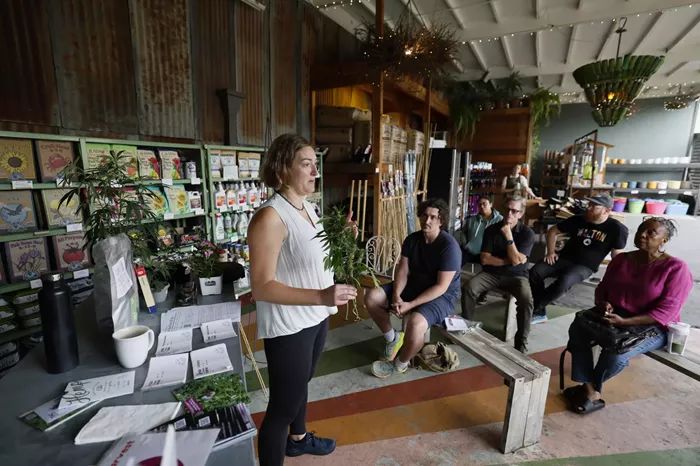As the fall season arrives, many cannabis growers are preparing to harvest their outdoor plants. Emily Gogol, co-founder of Grow It From Home, highlights two key factors in determining the optimal harvest time: the plant’s condition and your personal circumstances.
Harvesting Basics
Harvesting cannabis involves cutting each bud-laden branch from the main stalk and hanging it for drying. Use one of the natural notches on the branch as a hook and suspend it on a clothesline, construction netting, or a drying rack.
Early Spring Workshops
Earlier this year, Emily Gogol and Penny Barthel traveled across Los Angeles, hosting USDA-sponsored Grow It From Home workshops. Their message was clear: growing cannabis in your backyard is as manageable as cultivating tomatoes, and Southern California offers ideal conditions for this endeavor.
This led many new gardeners, including myself, to plant cannabis seeds. Under California law, it is legal for adults 21 and older to grow up to six plants, provided they are kept in a locked, non-visible area. Regulations may vary depending on your location.
Harvesting Tips
As the growing season winds down, the Grow It From Home team is back, offering guidance on harvesting. Last Saturday, at Fig Earth Supply in Mount Washington, Gogol shared practical, science-based advice with novice growers.
When to Harvest
The timing of the harvest depends on the plant’s development and personal needs. According to Gogol, there is no perfect time to harvest cannabis. “There’s about a week or two of flexibility. Harvesting early may result in a lower yield, while waiting could increase your yield. If you need to harvest before going on vacation, it’s fine to do so,” she explained.
Gogol advises checking three indicators for the right harvest time:
Trichomes: These crystal-like structures on the buds and leaves start clear and turn milky white, then brown as they mature. A jeweler’s loupe can help you inspect them. Harvest when most trichomes are brown.
Stigmas: The hair-like structures on the buds turn brown and dry as they mature. This change signals that harvest time is near.
Squish Test: Start testing your buds from September. Squeeze a nug and assess its firmness. Immature buds are spongy, while mature ones are firm. This test is particularly useful for determining readiness.
Pre-Harvest Preparation
Before harvesting, prepare for drying by finding a suitable space that is cool, dark, and has low humidity. Ideal drying conditions are temperatures below 80 degrees Fahrenheit, with humidity under 60%. You can use a guest room, closet, or garage. If you’re drying in a more humid environment, use a fan to improve air circulation.
Equipment
You’ll need basic pruning shears and a method to hang the branches. Options include a clothesline, laundry rack, or a mesh drying rack. No special equipment is necessary.
Drying Process
After harvesting, hang the branches to dry. If drying whole branches with colas, expect the process to take 7 to 14 days. For quicker drying, remove buds from branches and dry them separately.
To check if your buds are properly dried, cut open a nug after a week. The center should no longer feel wet. If it still feels damp, allow the buds to dry for a few more days before rechecking.
Storage Tips
For long-term storage, Gogol recommends airtight Mylar bags, Mason jars, or tins over Ziploc bags, which can affect flavor. Store your dried cannabis in a dark, cool place to prevent exposure to sunlight, which can degrade quality.
Final Advice
Gogol’s final tip for new cannabis growers: “Cannabis is precious and still illegal in many areas, but once you start growing at home, you’ll find it abundant. Expect to harvest about a pound of dried flower per plant, so there’s no need to worry too much.”
Related topics:
- Short Corn Could Replace Tall Cornfields Affected by Climate Change
- Flowers That Paint Themselves: Nature’s Masterpieces
- Garden Club Focuses on Invasive Plants in Upcoming Program


